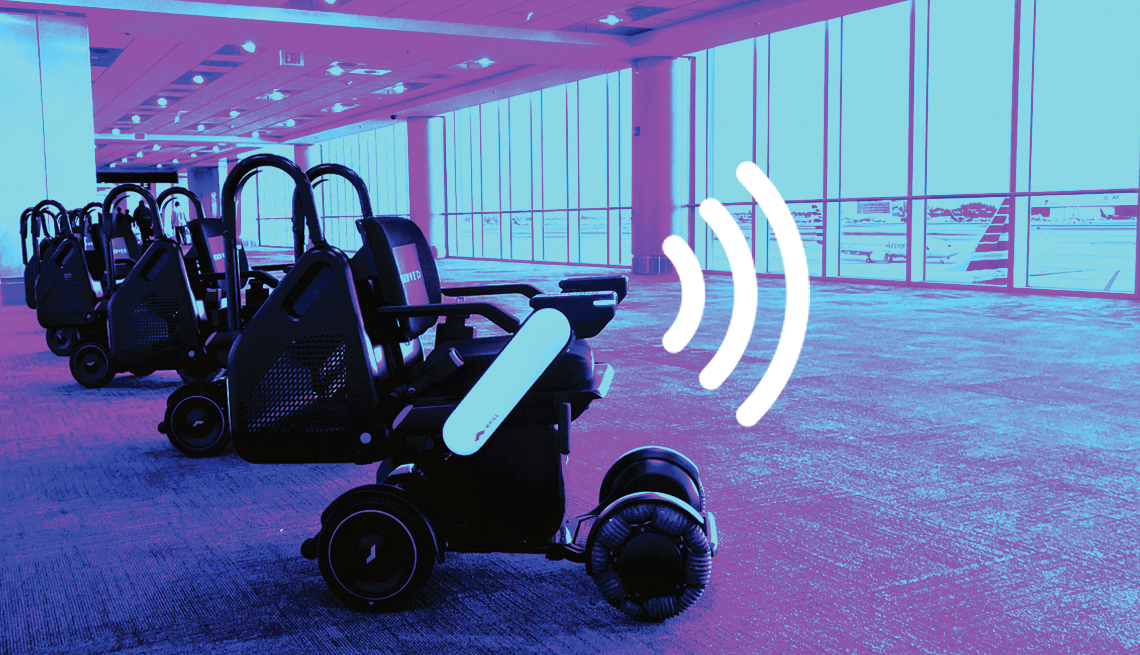When I first saw it, I was sure my eyes deceived me: an empty, self-propelled wheelchair made its way through a busy Miami airport terminal, its sensors maneuvering it around kiosks and travelers. It reminded me of my robot vacuum cleaner at home, stopping to avoid a collision but determined to follow its path, and I was curious enough to follow it. I watched as it made a beeline for a destination station where other chairs waited for passengers to type their destinations into the touchscreens and be whisked away.
These automated wheelchairs, which were recently introduced in the U.S. at Miami International and Los Angeles International airports, offer travelers with limited mobility more independence and alleviate the inconvenience that comes with relying on an unknown person to get from point A to point B. They come at an important time, as people with limited mobility are the fastest-growing demographic in the aviation industry, according to AviationPros.com. A recent AARP study found that 14 percent of travelers over the age of 50 are expected to require disability accommodations in 2024, with 78 percent of them hoping for mobility aids. That demand will only grow, as the U.S. Census Bureau projects that the population of Americans ages 65 and older will grow by 42 percent by 2050.
Now, American Airlines and its subsidiary Envoy Air, which operates American Eagle flights, ground handling and customer service, have partnered with autonomous manufacturer WHILL to offer free robotic wheelchairs to passengers traveling through Miami and Los Angeles international airports. Miami and Los Angeles join Canada’s Winnipeg Richardson International Airport and Japan’s Haneda, Narita International and Kansai International airports in offering passengers a robotic wheelchair option, says Tres Izzard, president of WHILL Mobility Services North America.
As this option becomes more common among airlines and airports, here’s what you need to know about these mobility aids.

Once you are sitting in your wheelchair, use the touchscreen to select your language and tap the gate for your departure.
Courtesy of WHILL Autonomous
How does it work?
You can ask for an autonomous wheelchair on the day of travel or request wheelchair assistance when booking. Just speak to a staff member at the airport so they can direct you, says Adam Simmons, Envoy Air’s director of communications. When passengers arrive on a return flight, they will be met by members of the support team at the arrivals and transfer boarding bridge, he says.
Simmons says connecting passengers “may be taken to a comfort zone (a waiting area for passengers requiring mobility assistance) on traditional service and then, after speaking with our team, may use a WHILL autonomous wheelchair to get to their connecting gate.”
According to WHILL, your carry-on luggage can be stored in the compartment directly behind the wheelchair seat. Once you’re seated, use the touchscreen to select your language. Tap the gate for your departure and you’re ready to go.
Each autonomous wheelchair is programmed to follow a path that is considered safe and efficient, the company says. Cameras and sensors detect other passengers and obstacles along the way. You’ll hear a beep as the wheelchair alerts other travelers to your presence and navigates around them, something I noticed when I observed these wheelchairs in Miami. The beeping was much quieter and more discreet than the traditional golf carts at the airport. Simmons adds that you’re never completely on your own: A staff member monitors the chairs and passengers as the devices move through the airport.
When you arrive at your gate, you must take your carry-on baggage and personal items with you as you walk down the jetway to board the plane – these devices can only be taken as far as the gate. Simmons says once your flight has taken off, the autonomous wheelchair is programmed to return to the comfort station or check-in area and be ready for the next passenger.


